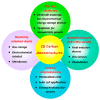Oriented Carbon Nanostructures by Plasma Processing: Recent Advances and Future Challenges
- PMID: 30715064
- PMCID: PMC6265782
- DOI: 10.3390/mi9110565
Oriented Carbon Nanostructures by Plasma Processing: Recent Advances and Future Challenges
Abstract
Carbon, one of the most abundant materials, is very attractive for many applications because it exists in a variety of forms based on dimensions, such as zero-dimensional (0D), one-dimensional (1D), two-dimensional (2D), and-three dimensional (3D). Carbon nanowall (CNW) is a vertically-oriented 2D form of a graphene-like structure with open boundaries, sharp edges, nonstacking morphology, large interlayer spacing, and a huge surface area. Plasma-enhanced chemical vapor deposition (PECVD) is widely used for the large-scale synthesis and functionalization of carbon nanowalls (CNWs) with different types of plasma activation. Plasma-enhanced techniques open up possibilities to improve the structure and morphology of CNWs by controlling the plasma discharge parameters. Plasma-assisted surface treatment on CNWs improves their stability against structural degradation and surface chemistry with enhanced electrical and chemical properties. These advantages broaden the applications of CNWs in electrochemical energy storage devices, catalysis, and electronic devices and sensing devices to extremely thin black body coatings. However, the controlled growth of CNWs for specific applications remains a challenge. In these aspects, this review discusses the growth of CNWs using different plasma activation, the influence of various plasma-discharge parameters, and plasma-assisted surface treatment techniques for tailoring the properties of CNWs. The challenges and possibilities of CNW-related research are also discussed.
Keywords: carbon nanostructures; carbon nanowall; graphene nanowall; plasma-enhanced chemical vapor deposition.
Conflict of interest statement
The authors declare no conflict of interest.
Figures














References
-
- Kroto H.W., Heath J.R., O’Brien S.C., Curl R.F., Smalley R.E. C60: Buckminsterfullerene. Nature. 1985;318:162. doi: 10.1038/318162a0. - DOI
-
- Ando Y., Zhao X., Ohkohchi M. Production of petal-like graphite sheets by hydrogen arc discharge. Carbon N. Y. 1997;35:153–158. doi: 10.1016/S0008-6223(96)00139-X. - DOI
-
- Machino T., Takeuchi W., Kano H., Hiramatsu M., Hori M. Synthesis of platinum nanoparticles on two-dimensional carbon nanostructures with an ultrahigh aspect ratio employing supercritical fluid chemical vapor deposition process. Appl. Phys. Express. 2009;2:025001. doi: 10.1143/APEX.2.025001. - DOI
Publication types
Grants and funding
LinkOut - more resources
Full Text Sources

